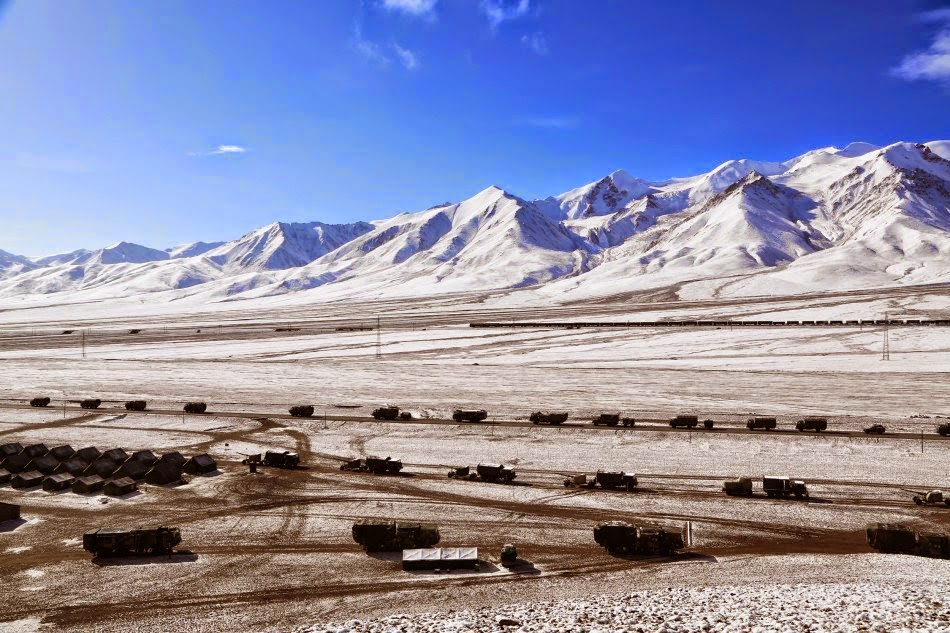This marks the conclusion of our 3-part series (read the first two parts here and here) on China’s integrated air defence system (IADS). This last installment focuses on China’s AD network in Tibet, since that is the place where Chinese military deployments are of the greatest relevance to India.
As we have noted before, the presence of the People’s Liberation Army Air Force (PLAAF) in the Tibet Autonomous Region (TAR) is still somewhat limited, albeit growing. It is therefore time to take a closer look at the current state of China’s AD network in TAR and the efforts that it has made in recent years to enhance the same.
Surveillance
Two Radar Regiments are deployed by PLAAF for the surveillance of Tibet and South Xinjiang region. Considering the elevated location of the PLAAF radars, the medium and high level surveillance capability of these radars is fairly good and they can reportedly monitor Indian air activities along large stretches of the Line of Actual Control (LAC).
Though the specifics of the radars and their exact locations are not known, some details about these PLAAF radars are available from open sources. Shigatse reportedly has a JL-3D-90A long-range airspace surveillance radar with an effective range of 330 Km alongside a SmartHunter low-probability-of-intercept (LPI) capable radar.
The world’s highest radar station at Ganbala is also in Tibet. Incidentally, the Ganbala radar station was till recently also the highest manned radar station in the world at a height of 5,374 meters above sea level. However, as per recent reports the manpower there was de-inducted in 2015, thereby making it an unmanned radar outpost. China has operationalized five such radars along LAC.
Nevertheless, even with a couple of Radar Regiments, the low-level surveillance cover within TAR remains poor, primarily due to terrain restrictions, leaving a number of assets denuded of early warning. As per some reports, though radar cover at most of the airports in TAR is poor, Shigatse is reported to have a JY-27 Radar with a range of over 300 Km. While the coverage of JY-27A Acquisition radar from Shigatse looks impressive, it needs to be noted that for most part, the air cover is over TAR and does not extend over Indian air space.
However, it needs to be considered that there are a number of radars e.g. the Ganbala radar that are closer to LAC which enhance the coverage of China’s AD network in the region.
Surface to Air Missiles
Though China has continually upgraded its overall territorial surface to air missile (SAM) and Defensive Counter Air coverage since the 1990s, its capability in TAR is still limited. To offset this limitation, china has started deploying a limited number of SAM systems in Tibet, mainly at select airfields.
Shigatse, now being upgraded into Tibet’s first all-weather air base capable of sustaining high-intensity offensive air sorties, is protected by a battery of HQ-12/KS-1A medium range SAM AD system and a combination of FN-6 man-portable air defence systems (MANPADS) and LD-2000 point-defence systems.
Interceptors
As we have written before, PLAAF till recently did not have any permanent deployment in TAR. The deployment pattern changed from 2010-2011 on wards. To develop its air space denial capability, a logistics exercise was conducted in August 2010 involving the Qinghai-Tibet Railway line by the PLAAF Logistics Department for the movement of “combat readiness materials” to Tibet. This reflected the growing role of PLAAF in maintaining security in TAR. The deployment pattern also changed from 2010. From a two to four week deployment, PLAAF started deploying an increased number of aircraft for longer durations.
Between August and November 2011, PLAAF deployed six Su-27SKs and three Su-27UBKs and three J-10s. While the SU-27s were moved back to their base(s), a four ship detachment of J-10As carried out a two week deployment in January 2012.
As per official Chinese media reports, there is an almost year-round presence of J-10, J-11 and SU-27 aircraft in the Tibet region on either deployment or for exercises. Winter deployment has also increased with China claiming that 32 J-10 fighter aircraft were positioned for the first time at Lhasa and Hoping through the winter of 2014, apparently carrying out over 1460 sorties.
To hone AD drills, PLAAF aircraft from Lanzhou MR undertook ‘combat confrontation’ engagements in all weather conditions, including in ‘low meteorological conditions’ in 2014 and this was repeated in 2015. Night flying and ‘confrontation drills’ by J-11 aircraft operating from Lhasa’s Gongga airfield were also reported by the Chinese media. The deployed PLAAF regiment ‘has begun paying much attention to the training of air battle at night’, which has become a routine training program in its annual training plan, as per official Chinese reports.
Conclusion
Despite these developments, PLAAF may yet be the weakest link in the Chinese military when it comes to the defence of Tibet. Nonetheless, recent trends indicate that China is addressing this concern and is looking to deploy a potent and robust AD capability on the roof of the world.
© Delhi Defence Review. Reproducing this content in full without permission is prohibited.
































